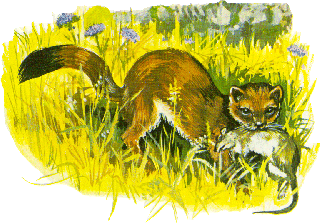

Stoats are great at catching rats
Irish Stoat ( Éasóg ) --: The stoat is the smallest of our flesh eating mammals
and is wrongly called a weasel. There are no weasels in Ireland. It was not until the eighteenth century that it was discovered that what was thought to be a weasel was really a stoat, but most Irish people still call our stoat a weasel. Unlike stoats from colder areas the
Irish stoat rarely changes to a white winter coat. In colder
countries the stoat will change to a complete white (except for the tip of
its tail) so he will not be seen easily in the snow. The winter white coat
is known as ermine and is expensive, as it is used to make fur coats for
some women.It is also used to put around kings capes.
The Irish stoat is about one foot long it has thin,tube like a body
with short legs and weighs about half a pound. The Irish stoat,
which is common throughout the country, is a darker and smaller relation
of the stoat found in England and Europe. They hunt mainly by scent. It is
very good at hunting and can tackle animals far bigger then itself.
It will attack rabbits and hares. It may also kill pheasants,duck and
hens and because of this farmers call stoats "vermin" and
usually put down poison to kill them. Some farmers like the stoat because
they are great at catching rats and mice around farmyards. Stoats are
normally quiet animals but when in trouble give out a sound like a small
bark. They can climb and swim very well. You might see them during the day
but they mainly hunt at night.
Stoats produce one litter per year.The young are born in
March or April. They do not build nests but use any old burrow, or tree
hollow.They take great care looking after their young. When the young are
a few weks old their parents show the young them, how to hunt and feed
themselves.The young stay with the parents much longer then most mammals.
I have never seen a stoat. I never heard of one until I was asked to do this
project. I know a lot about them now. I would like to see one someday. I
will see one soon when we go on our school tour to Dublin in the Natural
History Museum, but it will be dead.
Anto Sherlock